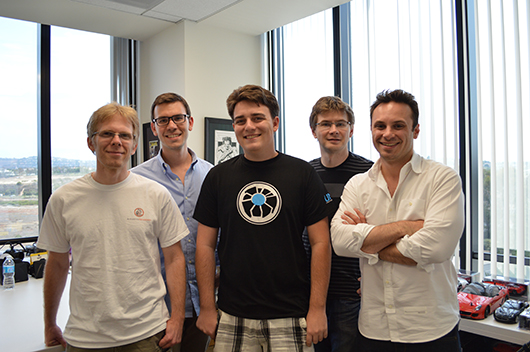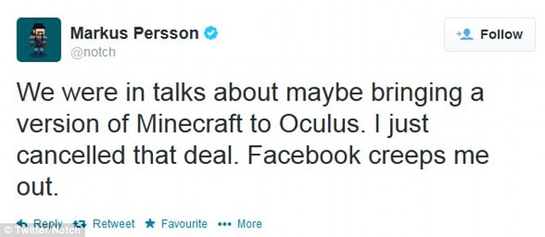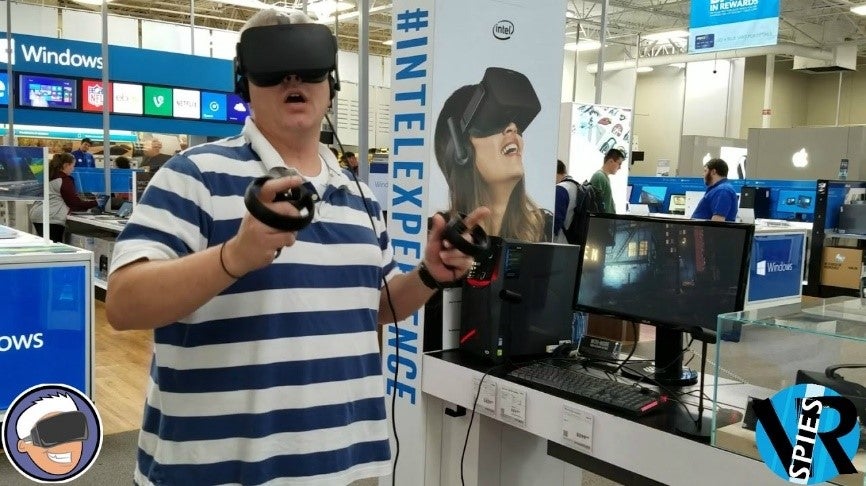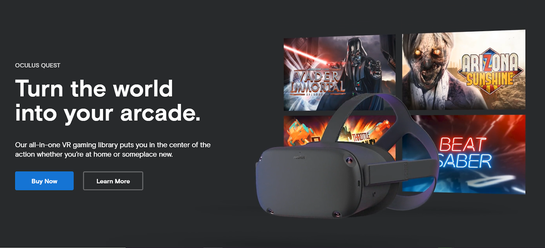How to Build Brand Recall in a Clickless World
Brand awareness is dwindling in organic search. Here's your strategy for building brand equity and recall by leveraging brand awareness. Learn more here.
Read More
Nine years ago, Oculus raised $2.5 million on Kickstarter. Two short years later, they were acquired by Facebook for a whopping $2 billion. Today, not only are its headsets featured prominently in every holiday gift guide, the company has forever transformed the virtual reality landscape.
But how exactly did Oculus grow from a crowdfunding sensation into a mass-market consumer brand so quickly? And what can other brands learn about keeping engagement and interest high after initial buzz and excitement dwindles? (Or, in Oculus’s case, when your acquisition faces widespread backlash.) Consider this everything you need to know about Oculus’s meteoric rise.
As a 15-year-old, Palmer Luckey was captivated by the idea of virtual reality. In his free time, he collected early VR headsets from the ‘80s and ‘90s, amassing a worthy collection from government auctions and industry liquidation sales. It was then that Luckey was inspired to build his own — or at least attempt to.
Then, a fateful encounter. In a forum dedicated to his beloved interest, Luckey found himself chatting with John Carmack, the renowned lead programmer of popular games including Doom, Wolfenstein 3D, and Quake.
Carmack, who also had a deep interest in VR headsets, was impressed by Luckey’s duct-taped prototypes. A few months later, Carmack would demo these same prototypes at E3, one of the biggest trade events for the gaming industry. This attracted significant attention — people’s excitement toward Luckey and Carmack’s new virtual reality project mounted in online forums. Within weeks, Luckey dropped out of college to officially launch his VR company, OculusVR.
Oculus’s Kickstarter page.
Encouraged by the hype at E3, the duo launched Oculus Rift on Kickstarter in August 2012, promising a VR experience unlike any other. Mind you, they weren’t pitching a polished and refined headset. In fact, the specs weren’t great, and the design was chunky. Still, VR enthusiasts and game developers were impressed by their ambitious plans to revive an industry where so many have failed. Within 24 hours, the project exceeded its $250,000 funding goal. By the end of its Kickstarter campaign, Oculus had raised $2.4 million.
The Oculus Rift DK1, which was what the company shipped out to backers, wasn’t perfect. The headset featured a low-resolution screen, making users feel like they were sitting too close to an old TV. It also lacked positional tracking (sensors to keep tabs on which direction your head is angled), limiting the type of experience that could be delivered. Other users complained that they suffered from motion sickness while using it. Still, this prototype was still better than everything else the industry has seen.
Despite these flaws, Oculus was thriving. The company sold out every single headset they could manufacture — 65,000 in total. Then, they made this strategic choice: Rather than meet the ongoing demand for more Rift DK1s, they would focus on innovating the second iteration of their headset, or what they referred to as a development kit. It was the right call — Rift DK2 was a hit.
The Oculus team.
Less than a week after its release, their hard work seemingly paid off: Facebook announced it had acquired Oculus for $2 billion. Armed with the tech behemoth’s resources, the company has seen tremendous growth. With an ever-increasing number of games compatible with Oculus devices, there are more than 500 games available in the Oculus Rift Store right now. Meanwhile, its headsets are widely available for mass purchase via every major electronic retailer, including Target, Best Buy, and Walmart.
It’s clear that Oculus’s quest to transform the VR industry is just beginning.
While Mark Zuckerberg, Palmer Luckey, John Carmack, and others on the Oculus team were celebrating the Facebook acquisition, not everyone was happy. In fact, people were outspokenly upset and even angry at the news. After the announcement, Notch, the creators of Minecraft, immediately and publicly canceled its plans to create a version of their game for Oculus Rift. Facebook’s stock dropped by 7%. Some Kickstarter backers withdrew their orders for Rift DK2. Redditers even mourned the death of Oculus.
Minecraft scraps the Oculus deal following news of the Facebook acquisition.
Overnight, the company went from homegrown indie darling to a subsidiary of a social networking giant that many in the tech industry disliked. To their diehard fans, the sudden identity and branding shift felt like a slap in the face. Rather than focusing on shipping orders, Oculus now had to prioritize keeping customers on their side.
Carmack defending the Facebook acquisition.
The team wasn’t fettered by the backlash, though. They published three posts reiterating their vision, beliefs, and goals of furthering VR technology and the possibilities that come with that. Meanwhile, Carmack wrote an honest Tweet about how the deal will keep VR and the company from suffering from scaling crises.
Although Oculus has become more integrated with Facebook since then, it remains very much its own brand, with a distinct style, tone and voice, and visual identity.
When Luckey and Carmack launched Oculus, they focused on developing VR to enhance the video game experience. However, in the last few years, the company has expanded in scope far beyond the gaming industry.
Now Oculus is eyeing even bigger opportunities. At the 2015 Consumer Electronics Show, Palmer Luckey said, “... it’s the idea of digital parallel worlds, allowing people to communicate and do things in a virtual world. Most don’t spend the majority of their time playing games now, and I can’t see that changing with VR — gaming is not the end game.”
Marriott’s “Travel Brilliantly” campaign.
So far, the company has strategically formed partnerships with leading brands, media players, and creative agencies to build VR experiences that do just that. For example:
Oculus’s first Kickstarter campaign was about tapping into a niche market — gamers, developers, and other tech aficionados. In its early stages, the only available games were Chronos and Edge of Nowhere, both of which were largely VR experiments.
As Oculus has expanded, so has its audience base. Now, most people who purchase the headsets are everyday gamers or even families. To dive into the mainstream market, the company was challenged to showcase the magic of VR rather than solely promote its products. They achieved this by creating affordable hardware and developing a more comprehensive range of content, such as the Climb, which gives users a life-like sensation of scaling up a mountain. (It’s the best-selling game in the Oculus Rift Store.)
For those unacquainted with VR — which, unsurprisingly, is most of the world — it can be difficult to understand, or even imagine, how a clunky-looking pair of goggles can transport you to a new world. Simply put, VR provides a powerful experience unlike any other.
The Best Buy Oculus demo station. Source
It can be a huge challenge to sell a product that shoppers have never seen before and don’t understand the value of. Here’s where strategic messaging comes in. “[Consumers] are constantly bombarded with words, advertisements, and calls to action,” said Jason Rubin, vice president of content at Oculus. “For example, every food has the word ‘extreme’ in front of it, to the point where no one pays any attention to it anymore. In our world, I think the equivalent word is ‘immersion.’” Instead of relying on jargon-y terms and emphasizing the features of Oculus headsets, the company’s marketing team strived to distill their value proposition into something more straightforward.
One of Oculus’s ads.
They’ve also chosen to focus heavily on in-store demos. At Best Buy, for example, shoppers can easily pick up a pair of Oculus headsets to try VR for themselves. This first-hand experience is an unmatched opportunity to convince a bottom-of-the-funnel shopper that not only does the technology work, but it’s also a super cool experience. Then, it’s just a matter of encouraging conversions via aspirational marketing that drums up shoppers’ FOMO, or “fear of missing out.”
In 2012, there was no VR industry. Today, Oculus has created a booming ecosystem around its vision. Despite the challenges they’ve faced along the way, the company has never lost sight of its goals.
“We’re now getting to the point where content made for VR is truly utilizing VR strengths and creating entertainment that’s very different from what anyone else has seen,” said Rubin. “With the [Marvel Powers United] and other upcoming announcements, you’re going to see bigger IP and bigger development studios and publishers getting into the business now that it’s growing.”
It’s clear that a huge reason for the company’s success is responsible growth, long-term strategy, and a deep understanding of their target audience’s desires, interests, and pain points, namely the lack of good VR content and the high price point of hardware. “We never thought it was going to be instant success for VR — we always knew it was going to take a long time,” Rubin also said. “You can look back at any of our statements, especially Mark Zuckerberg’s statements, [to know] how long it was going to take for VR to become mainstream, but we’re shifting into second gear, and third gear is on the horizon.”
It might even be true to say that Oculus was ahead of its time. Luckey certainly feels this way. In an interview with the Guardian, he acknowledged the social acceptance and societal change required for Oculus to see the success it currently enjoys.
“It’s easy to hate things until you actually need to use them. It’s like trying to predict our telephones. Go back to the 1800s and tell people you will be able to call anyone anywhere, and they’d picture a room full of phones and expect everyone to have to stay in that room with 20 telephones lining the wall. But that’s not how it worked out with everyone now carrying their own personal phone.”
From Kickstarter darling to Facebook subsidiary, Oculus has come a long way since the days of Luckey tinkering with spare parts in his garage. Despite the company’s rivals slowly catching up in terms of technical specs, Oculus’s savvy business strategies have cemented its role as the leader of the VR industry. Here’s how you, too, can power your way to success:
Last updated on December 3rd, 2025.
